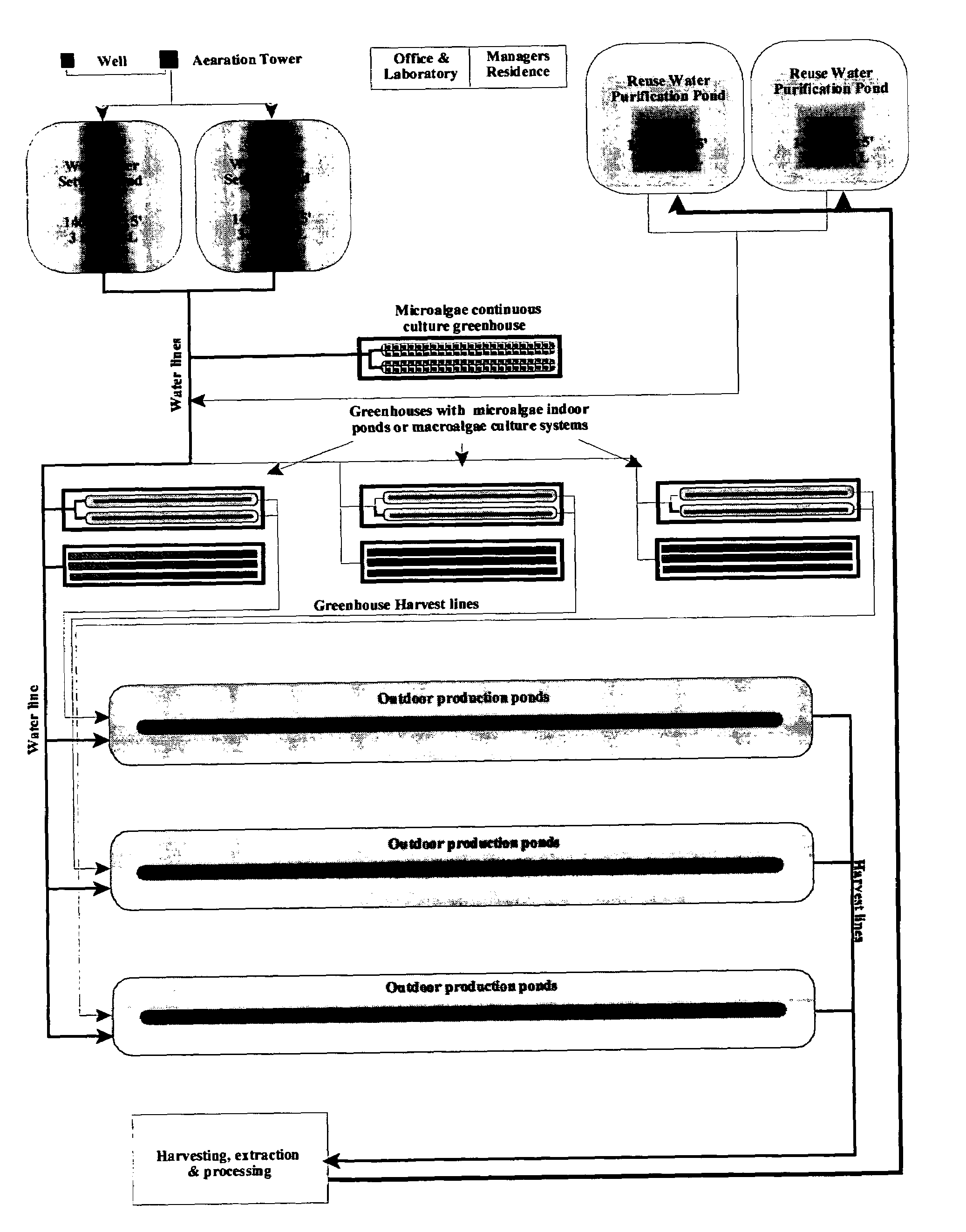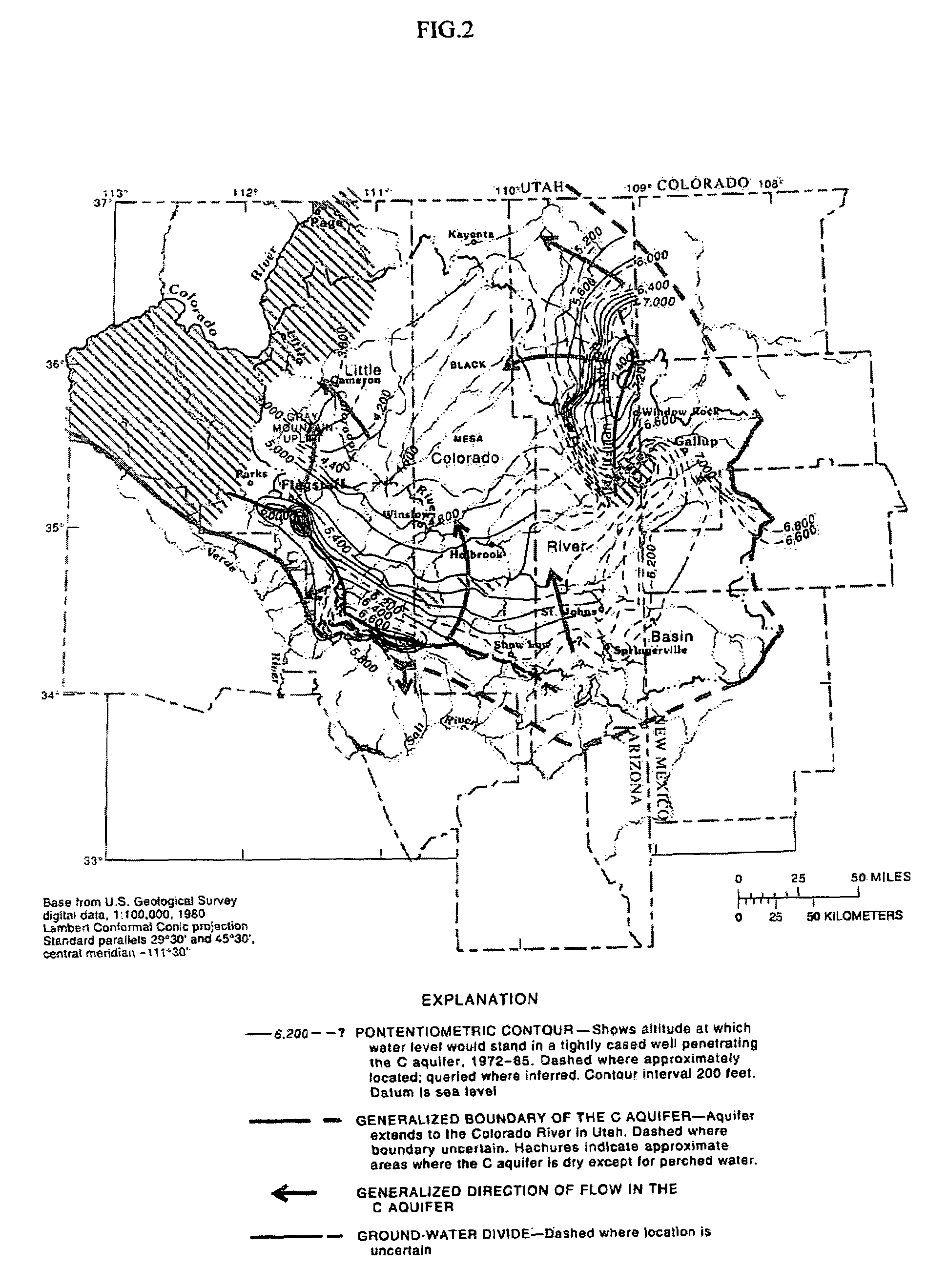Inland aquaculture of marine life using water from a saline aquifer
a technology of saline aquifer and inland aquaculture, which is applied in pisciculture and aquaria, applications, climate change adaptation, etc., can solve the problems of severely restricted wild population harvesting, large fish catch, and large fish catch
- Summary
- Abstract
- Description
- Claims
- Application Information
AI Technical Summary
Benefits of technology
Problems solved by technology
Method used
Image
Examples
example 1
[0104]The following process can be used to culture the microalgae Dunaliella bardawil. The algae are kept in continuous culture in a closed system containing filtered saltwater from the Coconino aquifer with a NaCl content of at least 1.5 M, which is fertilized with 1–500 mM and preferably 4 mM; K+, 0.15 mM PO4 3−, 4 mM NO3−, and 30 μM EDTA. pH is maintained by injection of CO2. 90% of this culture is harvested and used as an inoculum for a shallow (20–25 cm depth) pond within a greenhouse. The pond volume is 10 times the volume of the inoculum and is fertilized with the same concentration of fertilizers shown above. The illumination within the greenhouse is maintained at a level to maximize growth. Prior to the algae reaching stationary growth phase the pond contents are used as an inoculum for a shallow (25–30 cm) outdoor pond with a volume 10 times the volume of the inoculum. The outdoor pond is fertilized with the same concentration of fertilizers shown above and allowed to grow...
example 2
[0105]The following process can be used to culture the macroalgae Gracilaria verrucosa. In this process water from the Coconino aquifer, with a NaCl content of approximately 500 mM, is fertilized with the fertilizers NO3−, NH4+, PO43− and K+. This water is conveyed to a tank where it is stored until it is needed. The algae are attached to translucent pieces of plastic mesh and placed on a rack system. Nutrient media is sprayed over the algae in predetermined intervals. Excess water is collected beneath the algae, filtered, and returned to the storage tank. The nutrient media is checked periodically for concentrations of the various fertilizers. When a significant amount of growth is achieved the algae is harvested and packaged.
example 3
[0106]The following process can be used to co-culture Haliotis fulgens (green abalone) and Gracilaria parvispora (Ogo). This process is particularly useful in that the waste created by Haliotis fulgens is used as a nutrient source by Gracilaria parvispora. In this system water is continuously circulated between the algae culture facility and the abalone culture facility. Abalone are cultured in raceways that are about three feet wide, eight feet long and one and one half feet deep. The juveniles (3 to 5 mm) are placed into the raceways at a density of approximately 5000 per tank. They are fed the macroalgae Egregia, Ulva and Gracilaria. Water flow is about 10 to 50 L / min and the temperature is maintained at 21–25° C. The water from the abalone culture tank containing excreted NH4+ is passed through a rotating screen filter and a UV sterilizer to a holding tank. Water in the holding tank is monitored for NO3−, NH4+, PO43− and K+ concentrations and additions of NO3−, PO43− and K+ are ...
PUM
 Login to View More
Login to View More Abstract
Description
Claims
Application Information
 Login to View More
Login to View More - R&D
- Intellectual Property
- Life Sciences
- Materials
- Tech Scout
- Unparalleled Data Quality
- Higher Quality Content
- 60% Fewer Hallucinations
Browse by: Latest US Patents, China's latest patents, Technical Efficacy Thesaurus, Application Domain, Technology Topic, Popular Technical Reports.
© 2025 PatSnap. All rights reserved.Legal|Privacy policy|Modern Slavery Act Transparency Statement|Sitemap|About US| Contact US: help@patsnap.com



